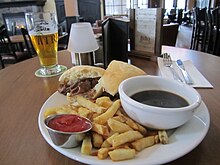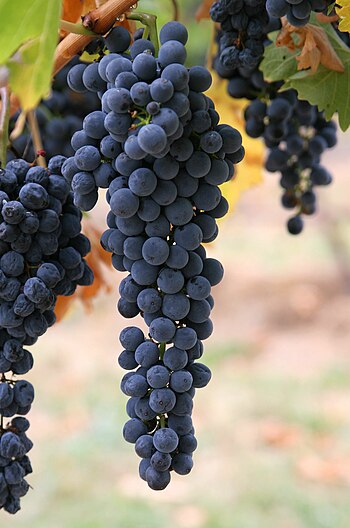Portal:Food
F o o d
A portal dedicated to food and foodways
Introduction


Food is any substance consumed by an organism for nutritional support. Food is usually of plant, animal, or fungal origin and contains essential nutrients such as carbohydrates, fats, proteins, vitamins, or minerals. The substance is ingested by an organism and assimilated by the organism's cells to provide energy, maintain life, or stimulate growth. Different species of animals have different feeding behaviours that satisfy the needs of their metabolisms and have evolved to fill a specific ecological niche within specific geographical contexts.
Omnivorous humans are highly adaptable and have adapted to obtain food in many different ecosystems. Humans generally use cooking to prepare food for consumption. The majority of the food energy required is supplied by the industrial food industry, which produces food through intensive agriculture and distributes it through complex food processing and food distribution systems. This system of conventional agriculture relies heavily on fossil fuels, which means that the food and agricultural systems are one of the major contributors to climate change, accounting for as much as 37% of total greenhouse gas emissions. (Full article...)
Cooking, also known as cookery or professionally as the culinary arts, is the art, science and craft of using heat to make food more palatable, digestible, nutritious, or safe. Cooking techniques and ingredients vary widely, from grilling food over an open fire, to using electric stoves, to baking in various types of ovens, reflecting local conditions. Cooking is an aspect of all human societies and a cultural universal.
Preparing food with heat or fire is an activity unique to humans. Archeological evidence of cooking fires from at least 300,000 years ago exists, but some estimate that humans started cooking up to 2 million years ago.
The expansion of agriculture, commerce, trade, and transportation between civilizations in different regions offered cooks many new ingredients. New inventions and technologies, such as the invention of pottery for holding and boiling of water, expanded cooking techniques. Some modern cooks apply advanced scientific techniques to food preparation to further enhance the flavor of the dish served. (Full article...)
Bacon ice cream (or bacon-and-egg ice cream) is an ice cream generally created by adding bacon to egg custard and freezing the mixture. The concept of bacon ice cream originated in a 1973 sketch on the British comedy series The Two Ronnies as a joke; it was eventually created for April Fools' Day by a New York ice cream parlour in 1982. In the 2000s, the English chef Heston Blumenthal experimented with ice cream, making a custard similar to scrambled eggs and adding bacon to create one of his signature dishes. It now appears on dessert menus in other restaurants. (Full article...)
Selected article –
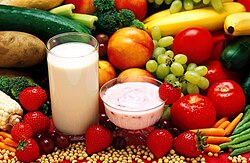
Vegetarianism is the practice of abstaining from the consumption of meat (red meat, poultry, seafood, insects, and the flesh of any other animal). It may also include abstaining from eating all by-products of animal slaughter.
Vegetarianism may be adopted for various reasons. Many people object to eating meat out of respect for sentient animal life. Such ethical motivations have been codified under various religious beliefs as well as animal rights advocacy. Other motivations for vegetarianism are health-related, political, environmental, cultural, aesthetic, economic, taste-related, or relate to other personal preferences. (Full article...)Selected cuisine -
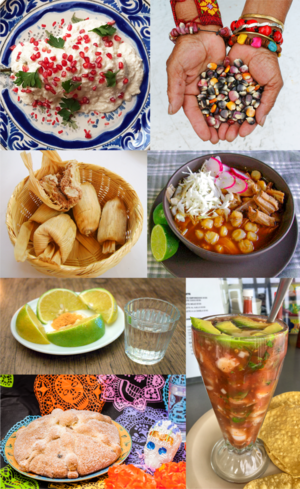
Mexican cuisine consists of the cooking cuisines and traditions of the modern country of Mexico. Its earliest roots lie in Mesoamerican cuisine. Its ingredients and methods begin with the first agricultural communities such as the Olmec and Maya who domesticated maize, created the standard process of nixtamalization, and established their foodways. Successive waves of other Mesoamerican groups brought with them their cooking methods. These included: the Teotihuacanos, Toltec, Huastec, Zapotec, Mixtec, Otomi, Purépecha, Totonac, Mazatec, Mazahua, and Nahua. With the Mexica formation of the multi-ethnic Triple Alliance (Aztec Empire), culinary foodways became infused (Aztec cuisine).
Today's food staples native to the land include corn (maize), turkey, beans, squash, amaranth, chia, avocados, tomatoes, tomatillos, cacao, vanilla, agave, spirulina, sweet potato, cactus, and chili pepper. Its history over the centuries has resulted in regional cuisines based on local conditions, including Baja Med, Chiapas, Veracruz, Oaxacan, and the American cuisines of New Mexican and Tex-Mex. (Full article...)Selected ingredient –
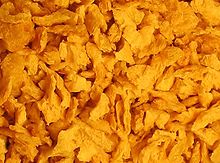
Textured or texturized vegetable protein (TVP), also known as textured soy protein (TSP), soy meat, or soya chunks, is a defatted soy flour product, a by-product of extracting soybean oil. It is often used as a meat analogue or meat extender. It is quick to cook, with a protein content comparable to some meats.
TVP may be produced from any protein-rich seed meal left over from vegetable oil production. Specifically, a wide range of pulse seeds besides soybean, including lentils, peas, and faba beans, may be used for TVP production. Peanut-based TVP is produced in China where peanut oil is a popular cooking oil. (Full article...)
Selected recipe –
A French dip sandwich, also known as a beef dip, is a hot sandwich consisting of thinly sliced roast beef (or, sometimes, other meats) on a "French roll" or baguette. It is usually served plain but a popular variation is to top with Swiss cheese, onions, and a dipping container of beef broth produced from the cooking process (termed au jus, "with juice"). Beef stock, a light beef gravy, or beef consommé is sometimes substituted. The sandwich is an American invention, with the name seeming to refer to the style of bread, rather than any French origin. Although the sandwich is most commonly served with a cup of jus or broth on the side of the plate, into which the sandwich is dipped as it is eaten, this is not how the sandwich was served when it was originally developed. (Full article...)
La Stazione may refer to:
- La stazione (1952 film), a documentary by Valerio Zurlini
- La stazione, or The Station (1990 film), an Italian comedy-drama by Sergio Rubini
- New Paltz station, New York, a former railroad station occupied by a restaurant formerly known as La Stazione (Full article...)
Selected image –
Selected biography –
B. June 8, 1784 – d. January 12, 1833
Marie-Antoine Carême (French: [maʁi ɑ̃twan kaʁɛm]; 8 June 1783 or 1784 – 12 January 1833), known as Antonin Carême, was a leading French chef of the early 19th century.
Carême was born in Paris to a poor family and, when still a child, worked in a cheap restaurant. Later he became an apprentice to a leading Parisian pâtissier and quickly became known for his patisserie skills. He was deeply interested in architecture and was famous for his large pièces montées – table decorations sculpted in sugar, depicting classical buildings. (Full article...)
Did you know (auto-generated) –

- ... that Cranksgiving has been described as "part bike ride, part food drive, part scavenger hunt"?
- ... that Cibo paints Italian food over neo-fascist graffiti?
- ... that the Sonoran blue butterfly uses Dudleya cymosa subsp. pumila as a larval foodplant and hummingbirds feed on its nectar?
- ... that the island bronze-naped pigeon is a popular food at bars and parties on São Tomé?
- ... that the horned sungem becomes a nectar robber when food is scarce?
- ... that a New York pop-up restaurant opened by Louisa Shafia served stews and rice dishes described in a review as a "Persian-tapas gateway into the ancient cuisine"?
More did you know –
Related portals
Food topics
The following are topics relating to food
Categories
Food list articles
- See also: Lists of foods and Category:Lists of drinks
The following are some Food list articles on Wikipedia:

- American cheeses
- Appellation d'Origine Contrôlée cheeses
- Apple cultivars
- Bacon dishes
- Bacon substitutes
- Basil cultivars
- Breads
- Breakfast beverages
- Breakfast cereals
- Breakfast foods
- British cheeses
- Cakes
- Candies
- Cheeses
- Cheese soups
- Christmas dishes (list)
- Cocktails
- Cookies
- Dishes using coconut milk
- Diets
- Doughnut varieties
- Egg dishes
- Fermented soy products
- Food additives
- Food additives (Codex Alimentarius)
- Foods named after people
- French cheeses
- French dishes
- Fried dough foods
- Fruits
- List of hamburgers
- Herbs and spices
- Hors d'oeuvre
- Indian dishes
- Indian snack foods
- Indonesian dishes
- Italian dishes
- Japanese snacks
- Japanese dishes
- Jewish dishes
- Kebabs
- Korean beverages
- Mango cultivars
- Moroccan dishes
- Pasta
- Pastries
- Philippine snack food
- Pies, tarts and flans
- Poppy seed pastries and dishes
- Potato dishes
- Puddings
- Raw fish dishes
- Rice dishes
- Rolled foods
- Sauces
- Seafood
- Seeds
- Sandwiches
- Snack foods
- Soft drinks by country
- Soul foods and dishes
- Soups
- Stews
- Street foods
- Tapas
- Turkish dishes
- Twice-baked foods
- Vegetable oils
- Vegetables
- Vodkas
Things you can do
Related WikiProjects
| Parent project: WikiProject Food and Drink | |
| Child projects: | Task forces: (All inactive) |
|
|
| Related projects: | |
New articles
Rules | Match log | Results page (for watching) | Last updated: 2024-05-09 19:22 (UTC)
Note: The list display can now be customized by each user. See List display personalization for details.
- Spaghetti alla siracusana (edit | talk | history | links | watch | logs | tools) by JackkBrown (talk · contribs · new pages (1)) started on 2024-05-09, score: 10
- Puffed rice cakes (edit | talk | history | links | watch | logs | tools) by 2003:CA:8718:D68F:4AEE:DFFA:5B34:E259 (talk · contribs · new pages (1)) started on 2024-05-09, score: 30
- Osmotherium (edit | talk | history | links | watch | logs | tools) by LaraPoasting (talk · contribs · new pages (2)) started on 2024-05-09, score: 10
- Fresh Thyme (edit | talk | history | links | watch | logs | tools) by 96.69.249.93 (talk · contribs · new pages (2)) started on 2024-05-09, score: 10
- Chicago Steak Company (edit | talk | history | links | watch | logs | tools) by AbrilTheCarpenter (talk · contribs · new pages (1)) started on 2024-05-09, score: 20
- Berry chantilly cake (edit | talk | history | links | watch | logs | tools) by BaduFerreira (talk · contribs · new pages (11)) started on 2024-05-01, score: 10
- Jason Fuller (edit | talk | history | links | watch | logs | tools) by The Bicycle of Dreams (talk · contribs · new pages (1)) started on 2024-05-08, score: 10
- Nikolay Vereshchagin (edit | talk | history | links | watch | logs | tools) by Kolya Muratov (talk · contribs · new pages (4)) started on 2024-05-07, score: 10
- Cardinal slice (edit | talk | history | links | watch | logs | tools) by Pek (talk · contribs · new pages (20)) started on 2024-05-07, score: 10
- Big Potato Man (edit | talk | history | links | watch | logs | tools) by B3251 (talk · contribs · new pages (32)) started on 2024-05-06, score: 10
- 2024–25 West Ham United F.C. season (edit | talk | history | links | watch | logs | tools) by Egghead06 (talk · contribs · new pages (2)) started on 2024-05-06, score: 10
- Tarte à l'badrée (edit | talk | history | links | watch | logs | tools) by Frankserafini87 (talk · contribs · new pages (6)) started on 2024-05-06, score: 20
- Café Avole (edit | talk | history | links | watch | logs | tools) by Another Believer (talk · contribs · new pages (70)) started on 2024-05-05, score: 10
- Subric (edit | talk | history | links | watch | logs | tools) by Frankserafini87 (talk · contribs · new pages (6)) started on 2024-05-05, score: 10
- Association of Estonian Food Industry (edit | talk | history | links | watch | logs | tools) by Estopedist1 (talk · contribs · new pages (5)) started on 2024-05-05, score: 20
- Ghost Note Coffee (edit | talk | history | links | watch | logs | tools) by Another Believer (talk · contribs · new pages (70)) started on 2024-05-05, score: 10
- Integrated Aqua-Vegeculture System (edit | talk | history | links | watch | logs | tools) by Wiki142B (talk · contribs · new pages (1)) started on 2024-05-05, score: 10
- Bark City BBQ (edit | talk | history | links | watch | logs | tools) by Another Believer (talk · contribs · new pages (70)) started on 2024-05-04, score: 10
- Fava (Greek dish) (edit | talk | history | links | watch | logs | tools) by Lambiam (talk · contribs · new pages (7)) started on 2024-05-04, score: 20
- Mian Nadeem Riaz (edit | talk | history | links | watch | logs | tools) by HRShami (talk · contribs · new pages (9)) started on 2024-05-03, score: 10
- Šumienkový zákusok (edit | talk | history | links | watch | logs | tools) by Aaa000000 (talk · contribs · new pages (4)) started on 2024-05-03, score: 20
- Pudingový koláč (edit | talk | history | links | watch | logs | tools) by Aaa000000 (talk · contribs · new pages (4)) started on 2024-05-03, score: 20
- Michelle Yoo (edit | talk | history | links | watch | logs | tools) by DrThneed (talk · contribs · new pages (21)) started on 2024-05-02, score: 10
- 2009 Peanut Corporation of America recall (edit | talk | history | links | watch | logs | tools) by Isochrone (talk · contribs · new pages (1)) started on 2024-05-02, score: 10
- Biscuit warmer (edit | talk | history | links | watch | logs | tools) by Wallclockticking (talk · contribs · new pages (5)) started on 2024-05-02, score: 10
- Meat jobber (edit | talk | history | links | watch | logs | tools) by GobsPint (talk · contribs · new pages (69)) started on 2024-05-02, score: 10
- Genevoise sauce (edit | talk | history | links | watch | logs | tools) by Frankserafini87 (talk · contribs · new pages (6)) started on 2024-05-02, score: 10
- Meat broker (edit | talk | history | links | watch | logs | tools) by GobsPint (talk · contribs · new pages (69)) started on 2024-05-02, score: 10
- Kolkata biryani (edit | talk | history | links | watch | logs | tools) by খাঁ শুভেন্দু (talk · contribs · new pages (2)) started on 2024-05-02, score: 10
- Branch house (building) (edit | talk | history | links | watch | logs | tools) by GobsPint (talk · contribs · new pages (69)) started on 2024-05-02, score: 20
- Walnut cake with egg yolk glaze (edit | talk | history | links | watch | logs | tools) by Aaa000000 (talk · contribs · new pages (4)) started on 2024-05-01, score: 20
- Tac/Quila (edit | talk | history | links | watch | logs | tools) by Another Believer (talk · contribs · new pages (70)) started on 2024-05-01, score: 10
- Underage club (edit | talk | history | links | watch | logs | tools) by Wallclockticking (talk · contribs · new pages (5)) started on 2024-05-01, score: 10
- Museum of Toruń Gingerbread (edit | talk | history | links | watch | logs | tools) by Dnaoro (talk · contribs · new pages (3)) started on 2024-05-01, score: 20
- Murau Brewery (edit | talk | history | links | watch | logs | tools) by 0Lucky Luke (talk · contribs · new pages (1)) started on 2024-05-01, score: 10
- Esther Choi (edit | talk | history | links | watch | logs | tools) by MemeDab99 (talk · contribs · new pages (3)) started on 2024-04-30, score: 10
- Greens powder (edit | talk | history | links | watch | logs | tools) by Psywave (talk · contribs · new pages (1)) started on 2024-04-30, score: 10
- Koffi (restaurant) (edit | talk | history | links | watch | logs | tools) by Another Believer (talk · contribs · new pages (70)) started on 2024-04-30, score: 10
- H. Avard Loomer (edit | talk | history | links | watch | logs | tools) by B3251 (talk · contribs · new pages (32)) started on 2024-04-30, score: 10
- Sherman's Deli & Bakery (edit | talk | history | links | watch | logs | tools) by Another Believer (talk · contribs · new pages (70)) started on 2024-04-30, score: 10
- Paul B. Wishart (edit | talk | history | links | watch | logs | tools) by Dmarsch (talk · contribs · new pages (6)) started on 2024-04-29, score: 10
- Meat water holding capacity (edit | talk | history | links | watch | logs | tools) by GobsPint (talk · contribs · new pages (69)) started on 2024-04-29, score: 10
- Meat diaper (edit | talk | history | links | watch | logs | tools) by GobsPint (talk · contribs · new pages (69)) started on 2024-04-29, score: 20
- Localis (restaurant) (edit | talk | history | links | watch | logs | tools) by Another Believer (talk · contribs · new pages (70)) started on 2024-04-29, score: 10
- Kōki Saitō (edit | talk | history | links | watch | logs | tools) by Cynikles (talk · contribs · new pages (1)) started on 2024-04-29, score: 10
- 24 in 24: Last Chef Standing (edit | talk | history | links | watch | logs | tools) by TristanQuinn (talk · contribs · new pages (1)) started on 2024-04-29, score: 10
- La Mejor Bakery (edit | talk | history | links | watch | logs | tools) by BaduFerreira (talk · contribs · new pages (11)) started on 2024-04-29, score: 20
- Wilson Davis (edit | talk | history | links | watch | logs | tools) by Vycl1994 (talk · contribs · new pages (22)) started on 2024-04-28, score: 10
- Sweet Rose Creamery (edit | talk | history | links | watch | logs | tools) by TrademarkedTWOrantula (talk · contribs · new pages (4)) started on 2024-04-28, score: 10
- Hunters Palm Springs (edit | talk | history | links | watch | logs | tools) by Another Believer (talk · contribs · new pages (70)) started on 2024-04-28, score: 10
- Haitian spaghetti (edit | talk | history | links | watch | logs | tools) by Valereee (talk · contribs · new pages (5)) started on 2024-04-27, score: 10
- Artocarpus styracifolius (edit | talk | history | links | watch | logs | tools) by Ulathijau (talk · contribs · new pages (2)) started on 2024-04-27, score: 10
- Atomo (edit | talk | history | links | watch | logs | tools) by White 720 (talk · contribs · new pages (2)) started on 2024-04-27, score: 30
- Ruditapes philippinarum (edit | talk | history | links | watch | logs | tools) by Sjl197 (talk · contribs · new pages (1)) started on 2024-04-27, score: 10
- Bonèt (edit | talk | history | links | watch | logs | tools) by Frankserafini87 (talk · contribs · new pages (6)) started on 2024-04-26, score: 20
- Ganmianpi (edit | talk | history | links | watch | logs | tools) by Iuliusnanus (talk · contribs · new pages (18)) started on 2024-04-25, score: 10
- D'Ambrosio Gelato (edit | talk | history | links | watch | logs | tools) by Another Believer (talk · contribs · new pages (70)) started on 2024-04-25, score: 10
Associated Wikimedia
The following Wikimedia Foundation sister projects provide more on this subject:
-
Commons
Free media repository -
Wikibooks
Free textbooks and manuals -
Wikidata
Free knowledge base -
Wikinews
Free-content news -
Wikiquote
Collection of quotations -
Wikisource
Free-content library -
Wikiversity
Free learning tools -
Wiktionary
Dictionary and thesaurus























